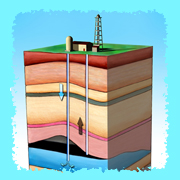Tell Me More Energy Science-SMART! Home
Natural Gas Formation, Exploration, and Distribution
What Is Natural Gas?
 Natural gas, also known as methane, is a colorless, odorless, clean-burning fossil fuel that provides about one-fifth of the energy used in our country. It is clean, easy to transport, and convenient to use. Natural gas is used for heating, cooling, lighting, cooking, as a fuel for home appliances and the production of electricity, and for many industrial uses.
Natural gas, also known as methane, is a colorless, odorless, clean-burning fossil fuel that provides about one-fifth of the energy used in our country. It is clean, easy to transport, and convenient to use. Natural gas is used for heating, cooling, lighting, cooking, as a fuel for home appliances and the production of electricity, and for many industrial uses.
Most geologists believe that natural gas was formed millions of years ago when plants and animals died and their decomposed remains were deposited with mud and silt. With time they were covered by sediments and were compressed by the weight of the sedimentary layers. As a result of intense heat and pressure, the organic materials were transformed into natural gas and oil. Some scientists believe that deep gas pockets were formed during the creation of the earth.
Natural gas is found trapped in impermeable layers of rock in different underground formations such as shale formations, coal seams, sandstone beds, and deep, salt-water aquifers.
How Natural Gas Is Obtained
Before drilling, geologists and geophysicists are employed to try to find the right conditions for a gas or oil deposit. Geologists employ sophisticated technology to try to find pockets of natural gas below the earth’s surface. They need to have a clear picture of what is below the earth’s surface.
They use seismology, a process in which shock waves (like tiny earthquakes) are passed through hidden rock layers. The waves that are reflected back to the surface are captured as digital recordings, which are then transformed into a visual representation of what is below the earth's surface.
High-speed computers are also used to help develop three-dimensional underground maps that help locate gas deposits. Computers are also used to analyze satellite images of surface rocks and terrain.
Magnetometers are used to get measurements of magnetic characteristics of the crust. This device is able to measure small changes in the Earth's magnetic field at the surface, which indicates what kind of rock formations might be present underground.
The only way to actually find the gas deposits is to drill. Gas wells are drilled thousands of feet into the earth's crust to extract natural gas from pockets in underground rock formations or from deep, salt-water aquifers. Big pumps then carry the natural gas to the surface.
The location of the gas pocket and the type of rock formation determine what type of drilling equipment is used. Cable drilling rigs are used for shallow formations, and rotary drilling rigs are employed for deeper formations. Drilling offshore requires a base to be built, whereas onshore drilling uses land for a base. The floating drilling platform needs a mechanism for attaching it to the base of the ocean floor,and the pitching and rolling of the ocean must also be factored into the design.
How Natural Gas Is Distributed
After processing, where an odor is added to help people identify gas leaks, natural gas is compressed and distributed through pipelines to storage facilities. The gas is then sent from smaller pipes to homes, offices, stores, and factories. Natural gas is used for heating, lighting, cooling, and cooking, and as a fuel for home appliances and for the production of electricity.



